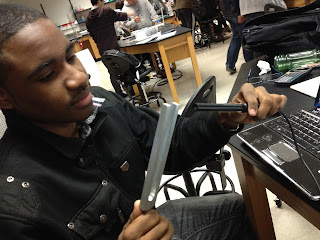In this experiment we recorded different sounds and looked at the graphs of their sound pressure vs. time. This helped us examine the different patterns of different sounds. We began by recording my voice along producing the noise "AAAAAAAAA".
This graph represents the sound pressure created when this noise is produced over an interval of 0.03s. This wave is periodic because the period of the wave dissipates over time. There are also three waves shown in this picture because there are three peaks shown that dissipate over time. This interval of 30 times per second is equivalent to how fast a hummingbird can flap its wings. This depends on the species of the hummingbird, some can go faster or slower. The period of these waves are 0.01s +/- 0.005s. This was determining by examining the graph and looking at how long it takes for the graph to do one full cycle. The frequency of the wave can be determined by this equation. f = 1/T. f is the frequency and T is the period. When we input the value for the period the frequency is 100 Hz +/- 200 Hz. 200 Hz uncertainty was calculated by converting the error from the period. We can determine the wavelength of the wave by using this equation. v=fλ, v is the speed of sound, the frequency of the wave which also be expressed as 1/T. λ equals the wavelength so the final equation is. vT=λ and λ = 3.4m. +/- 0.01m. This value of uncertainty was determined by partial derivatives. Error = sqrt(∂T/∂v^2 + ∂v/∂T^2) ∂v/∂T in this case is zero because the speed of sound is absolute. Something in the classroom that is about that size would be the size of the keyboard on a laptop. The amplitude of the wave cannot be measured in this experiment.
One of my lab partners then recorded his voice and we also analyzed the data.
The sound waves of his voice dissipate slower than the waves from my voice did and there are also more waves when he recorded his voice. This wave is also periodic. There are four waves analyzed in this time interval as opposed to three. The period of a wave would be 0.0075s +/- 0.005s. The frequency of a wave would be 133 Hz +/- 200Hz. The wavelength of the wave would be λ = 2.55m +/- 0.01m. This value was obtained the same as before.
We also analyzed the sound of a tuning fork.
This data was produced when the tuning fork was producing a loud noise. The tuning fork produces a wave that looks like an ideal sine wave. It vibrates at a steady rate as opposed to the human voices. There are seven waves in this data of the tuning fork. The period is 0.004s +/- 0.005s. The frequency of the tuning fork is 250 Hz +/- 200Hz. The length of the wave is λ = 1.36m +/- 0.01m
We also recorded the tuning fork when it rang at a softer noise. We produced a softer noise by striking the tuning fork with less force. The period of this noise is the same as above, 0.004s +/- 0.005s. The frequency and wavelength are also the same at 250 Hz, and λ = 1.36m +/- 0.01m
The amplitudes of these two waves vary because they are vibrated at two different intensities.
Conclusion
A certain sound like "AAAAAAA" has the same shape no matter who makes the sound. The number of the waves created in a small interval varies based on the frequency of the person voice. A person with a deeper voice will produce less waves because it is at a lower frequency as opposed to someone with a higher pitched voice. The tuning fork however produces the same amount of waves not dependent on how hard it was struck. The amplitude of the waves differed depending on how loud the tuning fork was ringing at.







No comments:
Post a Comment